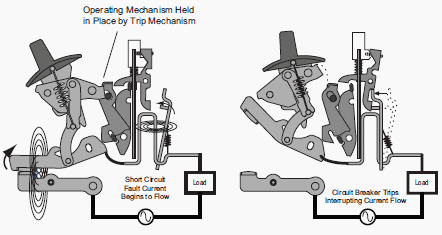
Our circuit breakers offer both thermal over-current trip-free and magnetichydraulic trip-free operation. An arc happens when the current delivery is interrupted when the breaker trips.

Also indicates the status of the circuit breaker On or Off tripped.
Trip free circuit breakers. Be considered Electrically Trip-Free the circuit breaker must be able to receive and respond to an electrical opening signal regardless of whether an electrical closing signal is energized. Mechanically Trip-Free operations refer to a mechanical release mechanism that can open the medium voltage circuit breaker regardless. A trip-free circuit breaker is a circuit breaker that will trip open even if the operating mechanism ON-OFF switch is held in the ON position.
A nontrip-free circuit breaker can be reset andor held ON even if an overload or excessive heat condition is present. This type of protection device will not allow the contacts of the C B contact of switch unitto be held closed while a fault current exists in the circuit the mechanism is known as TRIP-FREE circuit breaker. A trip free circuit breaker is one that will disconnect a circuit even if the manual switch is held at the on position.
It is a safety feature to prevent a circuit breaker being disabled either. Trip Free Circuit Breakers are circuit breakers which can trip even if they are held in the ON position. Hence it is not possible to forcibly keep them in the closed position.
Trip free circuit breakers are used in circuits with equipment which are sensitive to overload and in circuits which are not critical. While the test button is used to simulate the above-said mechanisms and test the response of the circuit breaker. Handle Trip-free Mechanism.
It is a handle used to open or close the breaker manually. It is also known as a trip-free mechanism because it will trip even if the handle is held in ON position. A circuit breaker has two types of tripping unit ie.
Thermal and magnetic tripping unit. The thermal tripping unit is used for protection against overloading. It uses a bi-metallic contact that bends with a change in temperature.
The current flowing through the bimetallic strip heats up contact trip the circuit breaker. They must deliver the load without overheating from a power surge or arc. Too much current or heat triggers fault parameters and then causes the breaker to trip.
An arc happens when the current delivery is interrupted when the breaker trips. An arc is extremely hot and erodes the contact material in the circuit. Operating mechanism Provides a means of opening and closing the circuit breaker.
Contacts Allows the current to flow through the circuit breaker when closed. Arc extinguisher Extinguishes an arc when the circuit breaker interrupts a fault. Trip unit Opens the operating mechanism in the event of a prolonged overload or short circuit.
Doble Engineering Company was used for this test. The TDR900 controls circuit breaker trip and close commands and supports the following operations. Trip O Close C Reclose O-03s-C Tripfree CO O-CO O-03s-CO First Trip O and Slow Close C.
When performing circuit breaker timing and travel measurements there are five primary signals that are of interest the TDR900 records all of these. Our circuit breakers offer both thermal over-current trip-free and magnetichydraulic trip-free operation. Circuit breakers can be reset manually or automatically to resume normal operation.
Thermal protection circuit breakers are temperature sensitive single and double pole fixed time delay push-to-reset or switch function and a compact design. Some molded case circuit breakers especially larger breakers can be manually tripped by pressing the PUSH TO TRIP button on the face of the circuit breaker. When the button is pressed the tripper bar rotates up and to the right.
This allows the trip mechanism to unlock releasing the operating mechanism. Curvature completing the circuit. For the trip-free manual reset device the contacts will remain open until the devices push button is depressed to reset the device and.
Trip-free mechanism 3AH4 vacuum circuit-breakers have a trip-free mechanism according to IEC 62271-100. In the event of an opening com-mand being given after a closing operation has been initiated the moving contacts return to the open position and remain there even if. Actuator lever - used to manually trip and reset the circuit breaker.
Also indicates the status of the circuit breaker On or Off tripped. Most breakers are designed so they can still trip even if the lever is held or locked in the On position. This is sometimes referred to as free trip or position trip operation.
A trip-free circuit breaker is a circuit breaker that trips even if the operating mechanism is held in the on position. A nontrip-free circuit breaker can be reset andor held on even if an overload or excessive heat condition is present. With the trip button held in the breaker will be kept in a trip-free state so a mechanism closing cycle will not cause contact movement especially when the breaker is being racked in or out.
Always use the correct racking mechanism wrench for racking a circuit breaker in or out otherwise the trip-free interlock feature may not function. Circuit Breakers Trip-Free Aircraft General Specification For. The primary function of this specification is to cover the general requirements of one- two- and three-phase often referred to as poles trip-free circuit breakers for use in aircraft electric systems conforming to.
SF6 Puffer Circuit Breaker - Mechanical compression of the arcing chamber generates SF6 gas pressure. SF6 Self-Extinguishing Circuit Breaker - Heat generated in the arcing chamber generates SF6 gas pressure. SF6 Double Dual Pressure Circuit Breaker - Uses a pressurized SF6 gas chamber that is released in the arcing chamber during operation.
The plunger hits the trip lever it causes the automatic release of the latch mechanism by opening the circuit breaker contacts. An MCB is a simple easily operable device and is maintenance-free too. MCB can be easily replaced.
The trip unit is the key part of the.